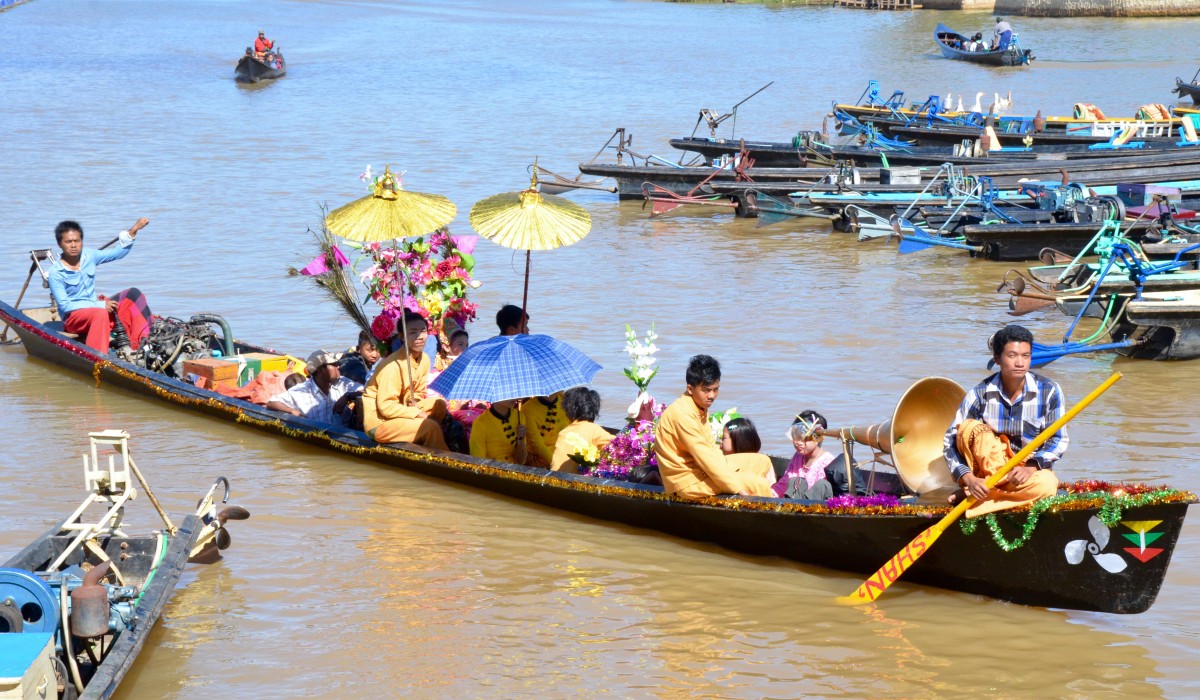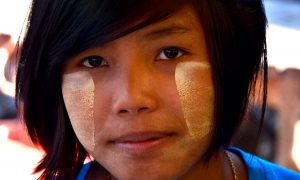
I love to plan. Yep, make lists. Research. Read. Ask questions. Organize stuff. Prioritize. But sometimes the most memorable travel experiences happen totally without any of that effort
This was the case recently in Myanmar, when we had glimpses of a traditional ceremonial event in the life of young boys called Novitiation or Shinbyu.
We saw this in the Inle Lake area in Shan State. Our charming and knowledgable guide, Min Min, told us it was quite unusual during the time of year we visited—November. He explained that most of the ceremonies are held in the spring when the boys are out of traditional school.
In Myanmar it is compulsory for boys to enter a Buddhist order for a week for more. A formal Novitiation ceremony involves a parade around the pagodas on the first day with the boys all dressed up as princes. In the afternoon their heads will be shaven and they will enter the Order. On the same day or the next there will be a feast for monks and invited guests.
Myanmar people regard their lives to be incomplete if they themselves, or their sons, have not been novices.
The tradition dates back to the time of the Buddha some 2,500 years ago when the Buddha granted His son the heritage of becoming a novice. Boys typically between 9 and 12 are beautifully dressed in princely attire that can be attributed to the fact that the Buddha’s son had been a prince himself.

Because life on Inle Lake occurs on the water, the boys we saw (two different ones) were taken by boat complete with decoration and booming music. Gosh, I would have loved to have been able to participate in the whole shebang but just seeing the parading part was really fun and a fascinating look at a religious tradition in this remote country.
My sense is that this ceremony is a bigger deal in Myanmar than weddings so the whole village turns out to celebrate. Hope you enjoy these images of the slice of the ceremony that we observed.

Some of the boys will only stay their compulsory week. Others will live and study in the monastery for years. For some it is the only way they will get an education. Some become full fledged monks.


















Comments
7 CommentsMargaret
Mar 1, 2016How lucky you were to see the Shinbyu…I wasn’t aware of the compulsory nature of this. I do wonder if you found it to be similar in Bhutan. Loved seeing your photos, as always!
Susan J. Smith
Mar 1, 2016Good question. We were not exposed to any kind of ceremony like this in Bhutan but we did see lots of young boys at the Monasteries. At one point it was the only way to get an education if you weren’t from a wealthy family with a tutor. We also visited nuns in Bhutan, again with small children.
Sha phurba
Mar 2, 2016Dear all
Thank you for the question? The practice is different here in Bhutan. We practice mahayana Buddhism. However, our monks are joined as early as 7 to 8 years and becomes the followers of Buddha. There is no celebration when they join. They simply change their red robs/ or dress and start learning Buddha dharma. As per the tradition, it is honor to send one of your son in monk, believing that he will be benifiting not only for himself but for the whole. This young monks can be from any family back ground. Mostly I would say they are from poor back ground because it is free to study with some little income. All though the goal is same at the end but we do not practice the shinbyu. Thanks
Susan J. Smith
Mar 4, 2016Thank you , Sha, for sharing this information. I appreciate the wonderful guiding you did on the trip I took to Bhutan March 2016 with GeoEX. We saw so much of your wonderful country. I appreciate your taking the time to answer the question proposed here on DesignDestinations.org
Sha phurba
Mar 4, 2016You are welcome! We would be very happy to share my knowledge on Bhutan and Buddhism. Any time feel free to ask me.
Thanks sha
peggy depersia
Mar 3, 2016As I read these blogs about the experiences you’ve had related to religious sites, ceremonies and rituals, I can’t help but see the similarities in practice within ancient religious traditions. still practiced today.
This particular ritual reminds me of the practice of ‘confirmation’ within the Catholic and perhaps some protestant religions in the ‘West’. Whether religiously motivated or naturally motivated it seems like there have long been practices that honor physical, spiritual or emotional development as young boys and/or girls transition from childhood to adulthood. I am always taken with the sanctity of such ceremonies and what they might mean for the participants.
Your blog also reminded me that it has long been considered an honor to have a ‘family’ member as part of the clergy, whatever clergy that might be.
Susan J. Smith
Mar 4, 2016Thank you Peggy, for your insightful comments. Always interesting to read what you have to say. I appreciate your taking the time to share and communicate.